Ecuador covers a territory of 109,483 square miles, straddling the Equator between Colombia (to the north) and Peru (to the south) in northwestern South America. Ecuador enjoys one of the most stunning portions of the Northern Andes Mountains. The country also lies along the northwestern fringes of the Amazon Basin and receives both warm and cold ocean currents along its equatorial Pacific Coast. The world-renowned Galapagos Islands have located 600 miles offshore.
Our goal is to insure that your trip to Ecuador and the Galapagos Islands is one of the most meaningful experiences of your life. We have learned that the way to experience the magic of this part of the world is through direct, first hand participation. We help you to achieve this in ways that invite you to interact with diverse ecosystems, ancient cultures and indigenous peoples. We are there to offer knowledge, and guidance that shares insights aimed at opening understanding. Both the Galapagos and mainland Ecuador are such unique and extraordinary places, we know your heart and mind will be captured, as ours once were almost three decades ago and will always remain.
Before you rush out to shop for your trip, we recommend you take a moment to read through this information in a place you find most conducive to thorough study.
San Cristobal Island is made up of two coalesced volcanoes. The southwestern half is asymmetric shield volcano made up of gently-dipping lavas and capped by a thick, deeply-weathered pyroclastic blanket and numerous satellite cinder cones. The southwestern shield became emergent around 2.4 million years ago; activity continued up to about 650,000 years ago. The northeastern half of the island is a more recently active volcano, dominated by eruptions from NE-trending fissures. The most recent flows are no more than a few centuries old.
San Cristobal Island is the only island with permanent freshwater, located near the highest part of the island (south) in a small lake called El Junco. The southern portion of the island is characterized by its rich vegetation, a result of the more humid climate.
Charles Darwin reported encountering a pair of giant tortoises feeding on cactus during his first landing on San Cristobal Island in 1835. Today the airport of this easternmost island in the chain is increasingly used as the arrival point for flights into and out of the Galapagos. The administrative capital for the province is Puerto Baquerizo Moreno on the southwestern shore, and in 1998 the Galapagos National Park Interpretation Centre opened for the benefit of islanders and travelers alike, presenting a comprehensive exhibit of the islands' natural history, human interaction, ecosystems, flora, and fauna. It is also the place where cultural activities take place, including theatre, exhibitions and workshops. From the Interpretation Center, a 3-kilometer loop trail arrives at Frigate Bird Hill, where both magnificent-frigates” and great-frigates can be seen in the same colony—ideal for learning to distinguish the two bird species. A 45-minute bus ride from town takes you to “El Junco,” one of the few permanent freshwater lagoons in the islands. Its location in the highlands of San Cristóbal ( 2,300 feet or 700 meters ) ensures our passage through a variety of vegetation zones. The lagoon on San Cristobal Island offers a scenic setting for exceptional bird watching including frigate birds that, in spite of being sea birds, go there to rinse the accumulated salt from their feathers.
Heading up the coast from Wreck Bay and Puerto Baquerizo, you will see Isla Lobos across a small channel off the coast of San Cristobal Island. This basalt island outcropping lives up to its name of “Sea Lion Island,” with its noisy population of frolicking and barking beasts. It is also a nesting place for blue-footed boobies and an excellent spot for snorkeling while on Galapagos cruises.
Playa Ochoa is located 6 miles from Puerto Baquerizo Moreno, the capital of San Cristobal Island and the Galapagos. The beach is small with easy access; here you'll find the Chatham mockingbird and various species of Darwin finches. Toward the rear of the beach is a little hyper-saline pond where white cheek pintails can often be seen wading. The beach also provides a chance for some introductory snorkeling.
Leon Dormido, also know as Kicker Rock, is a spectacular formation that rises 152 meters ( 500 feet ) out of the Pacific 4 miles off the central western coast of San Cristóbal. It takes the form of a sleeping lion or the Sphinx if you look at the rock from the south, but from the north, you can see that the stone is split, forming a large tablet and, piercing the sea, an excellent chisel ready for etching. Small vessels can navigate through the narrow channel between the two rocks that form Kicker Rock.
La Galapaguera is a tortoise reserve in seminatural conditions. This beautiful facility was built by the Galapagos National Park Service to provide the chance for visitors to San Cristobal Island to take a look at another race of giant tortoise, the Saddle Back. To reach the reserve, it's necessary to take a bus across the island from west to east. The ride takes 1 hour and the facility offers a dirt trail of easy access where 25 adult tortoises can be found in company with the very first babies to be born in captivity in this facility.



As previously described



As previously described



As previously described



As previously described
As previously described
Hood Island, or Espanola Island, is the southernmost island of the archipelago and is one of the most popular due to the breathtaking variation and a sheer number of fauna that greet the visitors.
A relatively flat island, with some hills; considered as one of the islands whose lavas were extruded beneath the sea and later uplifted to form the island. A group of geologists found evidence (1980) of volcanic activity, which occurred after the uplift.
On the northeastern shore of Hood Island, Gardner Bay offers a magnificent long white sandy beach, where colonies of sea lions laze in the sun, sea turtles swim offshore, and inquisitive Hood mockingbirds boldly investigate new arrivals. Your Galapagos cruise yacht will be anchored just a few hundred feet away. You will be lured into the turquoise water for a swim, but just a little further off-shore, the snorkeling by Tortuga Rock and Gardner Island offers peak encounters with playful young sea lions and large schools of surprisingly big tropical fish, including yellow-tailed surgeonfish, king angelfish and bump-head parrotfish. Sleepy white-tipped reef sharks can be seen napping on the bottom and sometimes Hammerhead sharks in a nearby location.
The quantity and variety of wildlife at Punta Suarez, on Hood Island, is remarkable. Sea lions surf the waves beyond the breakwater landing, and tiny pups are known to greet your toes upon arrival. A few steps inland you will find the most peculiar population of marine iguanas in the Galapagos. They bear distinctive red markings, some with a flash of turquoise running down their spine and legs, and nap in communal piles. The trail then takes us beside the western edge of the island where Nazca boobies (formerly known as Masked boobies) nest along the cliff’s edge and then descends to a rocky beach before rising to an open area and a large gathering of nesting blue-foot boobies. Galapagos doves, cactus finch, and mocking birds forage nearby, unconcerned by human presence on all of Hood Island. The trail continues to the high cliff edge of the southern shore; below, a shelf of black lava reaches out into the surf where a blowhole shoots a geyser of ocean water into the air. Within this area, along the cliffs is the “Albatross Airport” where “Waved albatross” line up to launch their great winged bodies from the cliffs, soaring out over the dramatic shoreline of crashing waves and driven spray. In the trees set back from the cliff is one of only two places in the world where the Waved albatross nests. In fact, the 13,000 pairs that inhabit Hood Island constitute a total endemic population of this species of birds, with the exception of a very small population that occasionally nest elsewhere on the continental part of Ecuador. Lucky visitors can watch courtship ‘fencing’ done with great yellow beaks and necks among the large, fluffy, perfectly camouflaged chicks. Mating occurs year-round.
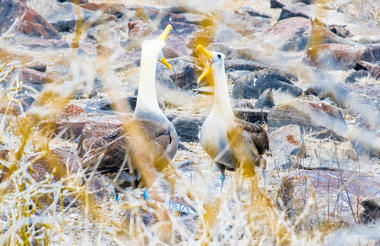


As previously described
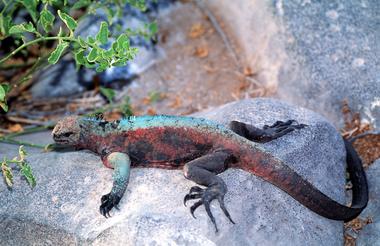

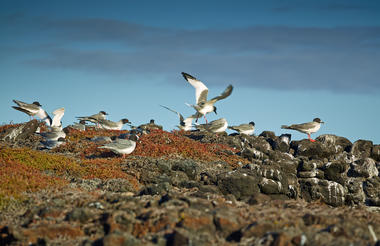
As previously described
Floreana is composed of a series of eroded volcanic hills whose form makes it virtually impossible to identify a central volcano. There are no signs of recent volcanic activity.
As reflected in its many names, Floreana Island has had a colorful history: Pirates, whalers, convicts, and a small band of somewhat peculiar colonists—a self-proclaimed Baroness among them—who chose a Robinson Crusoe’s existence that ended in mystery and death. Today roughly a hundred Ecuadorians inhabit the island. In 1793 British whalers set up a barrel as Floreana Island's Post Office to send letters home on passing ships. The tradition continues to this day, only by dropping a postcard into the barrel without a stamp. The catch is you must take a letter from the barrel and see that it gets to the right place. That is how the system began and continues to this day.
Punta Cormorant in Floreana Island offers two highly contrasting beaches; the strand where we land is composed of volcanic olivine crystals giving it a greenish tint that glitters in the sun. We descend here on our Galapagos cruises, and a trail crosses the neck of an isthmus—that rises from behind a small cinder cone—to a beach of very fine white sand known as “Flour Beach.” The erosion of coral skeletons formed Flour Beach. Between the two shores of Floreana Island is a hyper-saline lagoon frequented by flamingoes, pintails, stilts and other wading birds. Some 700 ft. north from the point is an old submerged volcanic cone that has been worn down by waves; Devil's Crown is home to a myriad of marine species including several species of corals, sea urchins, and many other creatures including a significant number of fish species, making this place one of the best snorkeling sites in the Galapagos. The eroded crater walls of Devil's Crown form a popular roosting site for sea birds including boobies and pelicans.
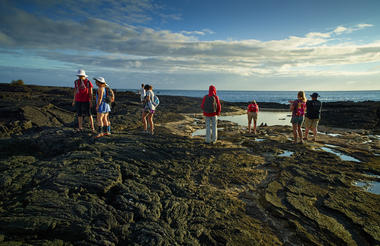

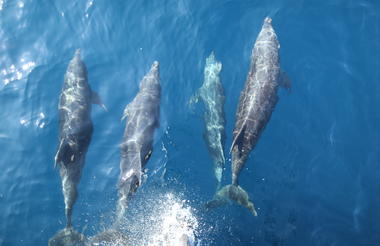
As previously described



As previously described
As previously described
Different parts of the island have varied origins, some with fresh lavas and spatter cones and others consisting of eroded tuff formations. Baltra Island used to be a US Air Force Base during World War II.
American soldiers in Baltra Island patrolled the nearby waters of the Pacific Ocean, including the entrance to the Panama Canal, for enemy aircraft carriers, warships, and submarines. When the war ended, the facilities in Baltra Island were handed over to the Ecuadorian Government.
Up until 1986, Baltra Island was home to the only airport in the Galapagos Islands. The airport now shares flights to the Galapagos with the San Cristobal Island airport, but it still receives the majority of flights from the mainland. Most cruise operators also start their cruise operations from Baltra Island. Also, because of its proximity to the largest port town in the Galapagos Islands (Puerto Ayora), most tourists who do island-based tours choose to arrive at the airport on Baltra Island.






